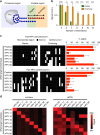Visual and modular detection of pathogen nucleic acids with enzyme-DNA molecular complexes
- PMID: 30104566
- PMCID: PMC6089962
- DOI: 10.1038/s41467-018-05733-0
Visual and modular detection of pathogen nucleic acids with enzyme-DNA molecular complexes
Abstract
Rapid, visual detection of pathogen nucleic acids has broad applications in infection management. Here we present a modular detection platform, termed enzyme-assisted nanocomplexes for visual identification of nucleic acids (enVision). The system consists of an integrated circuit of enzyme-DNA nanostructures, which function as independent recognition and signaling elements, for direct and versatile detection of pathogen nucleic acids from infected cells. The built-in enzymatic cascades produce a rapid color readout for the naked eye; the assay is thus fast (<2 h), sensitive (<10 amol), and readily quantified with smartphones. When implemented on a configurable microfluidic platform, the technology demonstrates superior programmability to perform versatile computations, for detecting diverse pathogen targets and their virus-host genome integration loci. We further design the enVision platform for molecular-typing of infections in patient endocervical samples. The technology not only improves the clinical inter-subtype differentiation, but also expands the intra-subtype coverage to identify previously undetectable infections.
Conflict of interest statement
The authors declare no competing interests.
Figures





Similar articles
-
Electrochemical detection of nucleic acids, proteins, small molecules and cells using a DNA-nanostructure-based universal biosensing platform.Nat Protoc. 2016 Jul;11(7):1244-63. doi: 10.1038/nprot.2016.071. Epub 2016 Jun 16. Nat Protoc. 2016. PMID: 27310264
-
Nucleic acid sensing with enzyme-DNA binding protein conjugates cascade and simple DNA nanostructures.Anal Bioanal Chem. 2017 May;409(14):3623-3632. doi: 10.1007/s00216-017-0304-z. Epub 2017 Mar 22. Anal Bioanal Chem. 2017. PMID: 28331958
-
Disposable nucleic acid biosensors based on gold nanoparticle probes and lateral flow strip.Anal Chem. 2009 Feb 15;81(4):1660-8. doi: 10.1021/ac8024653. Anal Chem. 2009. PMID: 19159221
-
Thin-film technology for direct visual detection of nucleic acid sequences: applications in clinical research.Expert Rev Mol Diagn. 2006 Jan;6(1):89-99. doi: 10.1586/14737159.6.1.89. Expert Rev Mol Diagn. 2006. PMID: 16359270 Review.
-
Signal Amplification Technologies for the Detection of Nucleic Acids: from Cell-Free Analysis to Live-Cell Imaging.Appl Biochem Biotechnol. 2017 Dec;183(4):1224-1253. doi: 10.1007/s12010-017-2494-4. Epub 2017 May 17. Appl Biochem Biotechnol. 2017. PMID: 28516415 Review.
Cited by
-
Single-Molecule FRET-Based Dynamic DNA Sensor.ACS Sens. 2021 Mar 26;6(3):1367-1374. doi: 10.1021/acssensors.1c00002. Epub 2021 Mar 15. ACS Sens. 2021. PMID: 33720708 Free PMC article.
-
Lateral flow assay: a promising rapid point-of-care testing tool for infections and non-communicable diseases.Asian Biomed (Res Rev News). 2023 Dec 28;17(6):250-266. doi: 10.2478/abm-2023-0068. eCollection 2023 Dec. Asian Biomed (Res Rev News). 2023. PMID: 38161347 Free PMC article. Review.
-
Scalable acoustic virtual stirrer for enhanced interfacial enzymatic nucleic acid reactions.Sci Adv. 2025 Mar 7;11(10):eadt6955. doi: 10.1126/sciadv.adt6955. Epub 2025 Mar 5. Sci Adv. 2025. PMID: 40043123 Free PMC article.
-
CRISPR-based Biosensors for Human Health: A Novel Strategy to Detect Emerging Infectious Diseases.Trends Analyt Chem. 2023 Nov;168:117342. doi: 10.1016/j.trac.2023.117342. Epub 2023 Sep 30. Trends Analyt Chem. 2023. PMID: 37840598 Free PMC article.
-
Empowering the on-site detection of nucleic acids by integrating CRISPR and digital signal processing.Nat Commun. 2024 Jul 25;15(1):6271. doi: 10.1038/s41467-024-50588-3. Nat Commun. 2024. PMID: 39054353 Free PMC article.
References
Publication types
MeSH terms
Substances
Grants and funding
LinkOut - more resources
Full Text Sources
Other Literature Sources

